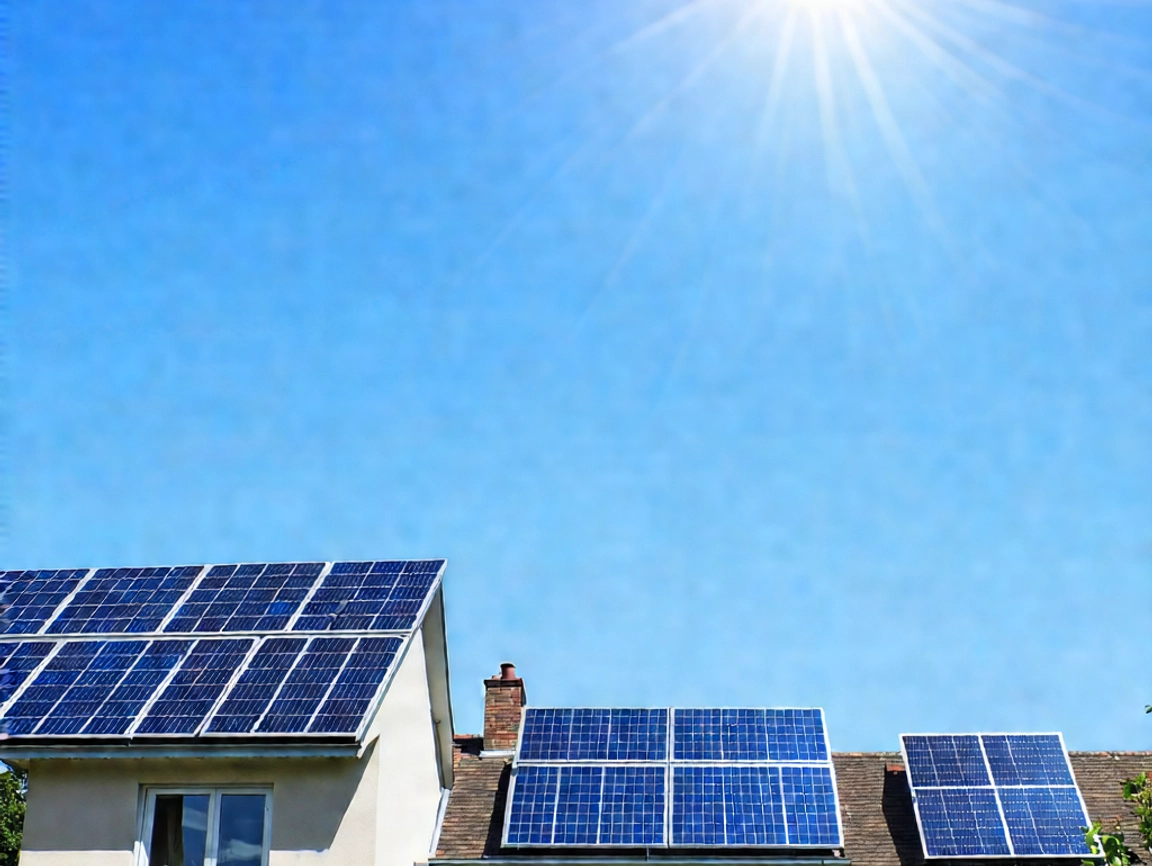Introduction to Solar Panels
Solar panels convert sunlight into electricity by utilizing photovoltaic (PV) cells. These cells are constructed from semiconductor materials, which generate an electric current when exposed to sunlight. The increasing popularity of solar panels can be attributed to their significant advantages, including environmental benefits, cost savings, and various government incentives designed to promote renewable energy sources.
One of the primary reasons for the growing interest in solar energy is its positive environmental impact. Unlike traditional fossil fuels, which emit greenhouse gases and contribute to climate change, solar energy is a clean and renewable power source. By harnessing sunlight, solar panels can help reduce carbon footprints and mitigate the effects of global warming. This shift to renewable energy sources is crucial for achieving sustainability goals and ensuring a healthier planet for future generations.
In addition to environmental considerations, solar panels also offer substantial economic benefits. Homeowners and businesses that invest in solar energy can enjoy lower electricity bills and increased energy independence. Many solar systems can produce surplus energy that can be sold back to the grid, allowing users to offset costs further. Government incentives, such as tax credits and rebates, are also available to encourage the adoption of solar energy, making it an increasingly feasible option for many households.
Integrating solar technology into residential and commercial properties is a testament to its viability and growing acceptance in society. As more individuals seek sustainable alternatives to conventional energy sources, solar installers are in higher demand to meet the needs of consumers. The transition to solar energy represents a significant trend and a critical step towards a sustainable, renewable energy future.
Benefits of Solar Panels
The installation of solar panels offers a multitude of advantages that can significantly enhance the appeal of switching to solar energy. One of the most prominent benefits is the reduction in electricity bills. By harnessing solar energy, homeowners can generate their electricity, thereby decreasing dependency on traditional electric grids. According to the U.S. Department of Energy, many households can save upwards of 50% on their monthly electricity costs, which translates into substantial annual savings.
Moreover, the installation of solar panels can lead to an increase in home value. Studies indicate that homes equipped with solar energy systems tend to sell for more than those without. A report by Zillow found that homes with solar installations typically carry a price premium of approximately 4.1%. This statistic underscores the growing market interest in energy-efficient homes and the economic viability of solar panels.
From an environmental standpoint, solar energy contributes positively by reducing carbon footprints. Utilizing solar power diminishes reliance on fossil fuels, which are known contributors to climate change and pollution. Each solar panel installation can eliminate several tons of carbon dioxide emissions annually, reinforcing the commitment to a sustainable future.
Additionally, various tax credits and incentives are available to encourage the adoption of solar technology. For instance, the Federal Solar Investment Tax Credit (ITC) allows homeowners to deduct a percentage of their solar panel installation costs from their federal taxes, thereby making solar energy more financially accessible.
Lastly, solar panels require low maintenance, as they are built to withstand various weather conditions and have long lifespans. Typically, only minimal upkeep, such as occasional cleaning and inspections, is needed. This aspect, combined with the enduring benefits and potential financial savings, makes solar panels an attractive option for homeowners considering sustainable energy solutions.
Environmental Impact of Solar Energy
Solar energy presents numerous environmental advantages that significantly reduce our reliance on fossil fuels. By harnessing the energy from the sun through solar panels, homeowners and businesses contribute to a more sustainable future. The transition to renewable energy sources, such as solar power, plays a crucial role in combating climate change and mitigating its adverse effects. Fossil fuel combustion for energy generates considerable greenhouse gas (GHG) emissions, which are a major driver of global warming. In contrast, solar energy production is nearly emission-free, therefore helping to decrease the overall carbon footprint.
Implementing solar panels can lead to a substantial reduction in GHG emissions as they replace traditional energy sources. For instance, utilizing a solar installer to set up photovoltaic systems can significantly cut back on carbon emissions when compared to fossil fuel-based energy generation. This transition not only promotes a healthier environment but also supports the global mission to limit temperature increases and reduce the overall impact of climate change.
Moreover, solar energy contributes to improved air quality. The combustion of fossil fuels releases various pollutants that can adversely affect human health and contribute to respiratory diseases. Adopting solar power means fewer harmful emissions, resulting in cleaner air and, ultimately, a healthier population. By reducing our dependence on non-renewable energy sources, solar panels contribute to the preservation of natural resources and the protection of ecosystems.
In addition, embracing solar energy fosters technological advancements and job creation within the renewable energy sector. As more individuals and organizations adopt solar technology, the demand for skilled solar installers has increased, bolstering local economies. The implementation of solar panels not only serves as a sustainable energy solution but also strengthens communities by promoting environmental stewardship and an emphasis on clean energy resources.
Potential Drawbacks of Solar Panels
While solar panels offer numerous advantages, it is essential to consider the potential drawbacks that accompany their installation. One of the most significant challenges is the high upfront cost associated with purchasing and installing solar systems. Although prices for solar technology have decreased over the years, the initial investment can still be substantial, which may deter some homeowners from moving forward with solar energy. However, it is worth noting that various financial incentives, such as tax credits and rebates, can mitigate these costs.
Another critical factor to consider is the dependency of solar panels on weather conditions. Solar energy production can be severely impacted during rainy, snowy, or cloudy days, leading to fluctuations in energy output. For instance, during prolonged overcast periods, solar panels may not be able to generate sufficient electricity to meet the household demand. This reliance on sunlight makes it essential for homeowners to have backup energy sources, which can add to overall energy costs and complexity.
Space requirements also constitute a consideration when it comes to solar panel installation. Solar energy systems require adequate space on rooftops or land to accommodate the panels effectively. In urban areas or with smaller properties, there may be insufficient space available to deploy a sufficient number of solar panels to generate the desired energy output. Additionally, during extreme weather events, such as hailstorms or hurricanes, solar panels can sustain damage that may necessitate costly repairs or replacements.
While these potential disadvantages do not negate the numerous benefits associated with adopting solar technology, they do highlight the importance of conducting thorough research, consulting a qualified solar installer, and assessing individual circumstances before deciding on solar panel installation. A balanced understanding of both pros and cons is crucial for homeowners looking to invest in solar energy.
Financial Considerations
The decision to install solar panels involves significant financial considerations that can greatly impact a homeowner’s budget. The initial investment for solar panels can be substantial, often ranging from $15,000 to $30,000, depending on the size and specifications of the system. However, this upfront cost can be offset over time through energy savings and available financing options. Many solar installers now offer varying financing arrangements, such as solar loans and leasing options, which allow homeowners to spread the costs over a longer period without having to pay upfront in full.
The long-term savings associated with solar panels can be quite impressive. By generating their own electricity, homeowners can significantly reduce their monthly utility bills. In some cases, individuals can even eliminate energy costs, resulting in substantial savings over the years. Furthermore, the payback period for a solar panel installation typically ranges between five to ten years, depending on the local energy rates and the amount of sunlight the panels receive.
Another essential factor to consider is the impact of government incentives on the financial aspects of solar energy. Various federal, state, and local programs provide substantial rebates, tax credits, or grants to encourage the adoption of solar energy. For example, the federal investment tax credit allows homeowners to deduct a percentage of the solar system costs from their federal taxes, making solar energy even more affordable. These incentives can effectively decrease the overall costs involved in installing solar panels and enhance the return on investment. By carefully evaluating these financial aspects, homeowners can make informed decisions about harnessing solar energy and enjoy its associated benefits.
Long-Term Maintenance and Durability
Solar panels represent a significant investment in renewable energy technology. Understanding the long-term maintenance and durability of solar panels is crucial for homeowners considering this sustainable option. Typically, solar panels have a lifespan of 25 to 30 years, during which proper maintenance can maximize efficiency and longevity.
The technology behind solar panels has advanced significantly, leading to more durable and reliable products. Modern photovoltaic (PV) panels are designed to withstand harsh weather conditions, including hail, high winds, and temperature fluctuations. Most manufacturers provide warranties that cover a performance guarantee of around 80% efficiency for 25 years, ensuring that the panels produce ample electricity for many years.
Maintenance requirements for solar panels are generally minimal compared to other home systems. Regular inspections are advisable to check for debris, such as leaves and dirt, that can impact their performance. In many climates, rain can naturally clean the panels, but in areas with less precipitation or where dust accumulation is an issue, periodic cleaning may be necessary. Homeowners can undertake this task or hire a solar installer to ensure the panels are thoroughly cleaned without damage.
Moreover, solar inverter maintenance is essential, as inverters typically last 5 to 15 years and may need to be replaced. Keeping an eye on performance metrics is crucial; users can monitor energy output through solar monitoring systems, allowing quick identification of issues that may affect efficiency.
Investing in solar panels not only benefits the environment but also has financial implications such as reduced electricity bills and potential tax credits. Understanding the long-term benefits and maintenance required will ultimately support homeowners in making informed decisions about their solar energy systems.
Installation Process and Considerations
The installation of solar panels is a systematic process that involves multiple steps and considerations to ensure optimal performance and compliance with regulations. The first step typically entails assessing your property’s suitability for solar panel installation. This involves evaluating factors such as roof orientation, shading from nearby trees or buildings, and the structural integrity of your roof. A solar installer can provide insights on whether modifications are necessary to accommodate the solar array adequately.
Once the site assessment is completed, the next phase is selecting a qualified solar installer. It is essential to choose a licensed installer with a proven track record in your area. This evaluation should include checking customer reviews, verifying certifications, and assessing the installer’s familiarity with local regulations and permitting processes. Engaging a local installer who understands your region’s solar benefits can significantly contribute to the efficiency and effectiveness of the installation.
Before installation can commence, obtaining the necessary permits is crucial. The requirements vary by jurisdiction, so it is advisable to understand local regulations that govern solar installations. Many municipalities require specific permits, which can cover everything from structural modifications to electrical work. The installer should assist you in navigating these regulations, ensuring compliance, and minimizing delays during the installation process.
Lastly, consider the long-term implications of solar energy on your property. Factors such as potential energy savings, increased property value, and possible federal or state incentives can all impact your decision. Understanding the total costs associated with installation, maintenance, and potential returns is vital. After careful consideration of these elements, you can make an informed decision regarding the adoption of solar panels. Each step in this process plays a significant role in maximizing the benefits of solar energy for your home or business.
Success Stories of Solar Panel Users
The adoption of solar panels has transformed the lives of countless homeowners and businesses, providing substantial energy savings and enhancing overall satisfaction with energy consumption. Many individuals who initially hesitated to switch to solar energy later became passionate advocates for its benefits, primarily due to their remarkable experiences.
For instance, a family residing in California reported that after installing solar panels, their monthly energy bills decreased by over 70%. This significant reduction allowed them to redirect their finances towards educational expenses for their children. Moreover, they noted the pride in contributing to a cleaner environment, highlighting the positive impact of solar energy on their lifestyle. The family’s satisfaction was further amplified by the reliable service provided by their solar installer, who guided them through the installation process and addressed their concerns comprehensively.
In the realm of business, a local restaurant in Florida decided to invest in solar panels to cut down on energy expenses. Upon installation, the owners observed an immediate decrease in utility costs, translating into thousands of dollars in annual savings. This financial relief enabled them to hire additional staff and expand their menu offerings. The increased visibility from their commitment to sustainable practices also attracted eco-conscious diners, allowing their business to thrive while supporting the local community.
These testimonials reflect a growing trend among users of solar technology. Many report enhanced property value, increased energy independence, and a stronger connection to their community through sustainable practices. As more individuals share their success stories, it becomes evident that the advantages of solar panels are both tangible and impactful. Such inspiring accounts of savings and satisfaction serve to motivate others to consider the solar benefits, ultimately fostering a more sustainable future.
Conclusion and Future Outlook
In evaluating the pros and cons of having solar panels, it becomes evident that these systems present significant advantages for homeowners and businesses alike. The solar benefits, such as decreased energy bills, increased property value, and a reduced carbon footprint, contribute positively to both personal finances and the environment. Furthermore, the capacity for energy independence that solar panels provide is increasingly appealing in our fluctuating economic landscape. However, it is essential to consider the potential drawbacks, including the upfront costs and the space required for installation. Consulting with a reputable solar installer can provide tailored solutions that mitigate these concerns.
Looking towards the future, the outlook for solar energy is promising. Advances in technology are continually enhancing the efficiency and affordability of solar panels. Innovations, such as improvements in battery storage solutions and the development of building-integrated photovoltaics, are expected to further integrate solar energy into everyday life. Additionally, as policy frameworks increasingly support renewable energy initiatives, the market for solar installations will likely expand.
The growing emphasis on sustainable energy sources reflects a global shift aimed at addressing climate change. Given such trends, individuals contemplating solar energy should view this as a suitable option for clean energy. With federal incentives and state rebates becoming more widely available, the financial barriers are gradually being broken down. As both technology and societal norms evolve, embracing solar energy may not only be a wise investment but also an essential step toward a more sustainable future. Adopting solar panels today could lead to benefits that extend well into tomorrow.










Comments are closed